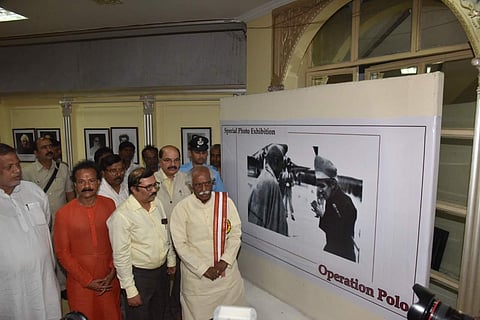
- LIFESTYLE
- FASHION
- FOOD
- ENTERTAINMENT
- EVENTS
- CULTURE
- VIDEOS
- WEB STORIES
- GALLERIES
- GADGETS
- CAR & BIKE
- SOCIETY
- TRAVEL
- NORTH EAST
- INDULGE CONNECT

At the museum, a photography exhibit features about 87 pictures from Operation Polo, a police action. The images chronicle the events of September 16 and 17, 1948, when Indian troops entered the state of Hyderabad. The exhibition was unveiled and inaugurated on September 15 by Bandaru Dattatreya, the governor of Haryana.
A careful reading of the images from the exhibit suggests that the general officer in the Indian army was in a serious conversation with the commander-in-chief of the Hyderabad State Forces. In yet another photo up there, crowds were cheering the Indian Army. The bold print of this picture leaves no doubt that the young men were impassioned with hope for freedom.
Hyderabad was ruled by the Asaf Jahi or Nizam dynasty until the time when the integration was accomplished through military operation. The seventh and final Nizam of Hyderabad, Mir Osman Ali Khan, declared a cease-fire, summoning closure to the conflict. For the residents of Hyderabad, the fight, which began on September 13, 1948, was a trying time.
On display at the Operation Polo photo exhibit were the Hyderabadi state officials and revolutionary leaders like Komaram Bheem, fighting for the then state of Hyderabad to liberate it from the clutches of feudal Nizams. Symbolising a sentiment against encroachment and exploitation, the Operation Polo exhibit familiarised the visitors with Hyderabad’s history and what it lost at the expense of war.
“Before Operation Polo occurred, the city was plagued by the stench of conservatism - the primary medium of education was Urdu. The ruler at that time did not allow a single room for inclusion or integration. It is of no surprise that cultural and religious freedom was miserably stifled,” said Dattatreya, emphasising the need for textbooks to speak about every fighter’s toil for emancipation so that the existing and following generations reassess their past.
“The history books only contain factual details without describing the period’s suppression, the inhumanity, the slavery, the culture distortion - how it all began and what it led to. I hope the exhibition fulfils this purpose,” he added.
Exhibitor Nagender Reddy shared with us his insights into Operation Polo’s display. “The purpose of this exhibition was mainly an educative and informative one,” he said, adding, “We chose as many as 87 photographs from the internet as well as other online sources, which we thought would communicate a stronger message about the historical event to the visitors.” Looking to intersperse history and information through the visual medium, Reddy noted that the general masses would be more sensitised to this monumental event since it led to Hyderabad’s liberation.
Operation Polo exhibition is continuing from September 15 up to September 30 at Salar Jung Museum.
Mail: chokita@newindianexpress.com
Twitter: @PaulChokita